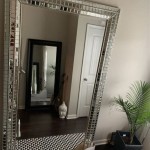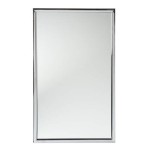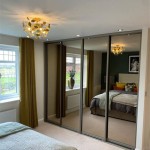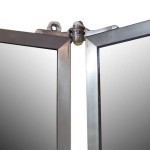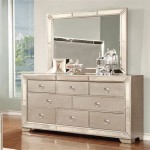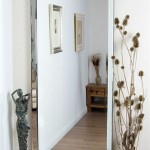Adding Trim to a Bathroom Mirror
Adding trim to a bathroom mirror is a simple yet effective way to elevate the room's aesthetic. This project can be completed with readily available tools and materials, offering a significant visual upgrade with minimal investment. Whether aiming for a modern, rustic, or traditional look, the right trim can transform a plain mirror into a stylish focal point.
Choosing the Right Trim
The selection of trim significantly impacts the final look of the project. Several factors should be considered, including the existing bathroom décor, the desired style, and the mirror's size and shape. Common trim materials include wood, plastic, and metal. Wood offers a classic and versatile option, adaptable to various finishes. Plastic trim is often more budget-friendly and moisture-resistant, a crucial factor in bathroom environments. Metal trims, such as aluminum or stainless steel, provide a sleek and modern aesthetic.
The trim's profile is another important consideration. Simple flat trims offer a clean, minimalist look, while more ornate profiles can add a touch of elegance or traditional charm. The width of the trim also plays a role in the overall visual impact. Wider trims create a bolder statement, while thinner trims offer a more subtle enhancement.
Before purchasing the trim, accurate measurements of the mirror are essential. Measure the perimeter of the mirror carefully to determine the total length of trim required. It is advisable to purchase slightly more trim than needed to account for cuts and potential mistakes.
Preparing the Mirror and Workspace
Proper preparation ensures a smooth and successful installation. The mirror surface should be thoroughly cleaned to remove any dust, grime, or residue that could interfere with the adhesive. A clean, dry surface is crucial for optimal adhesion. Cover the surrounding area with drop cloths or newspapers to protect the sink, countertop, and floor from adhesive and potential scratches.
Gather all necessary tools and materials before beginning the installation process. This typically includes the chosen trim, a strong adhesive appropriate for the trim material and mirror, a measuring tape, a miter saw or miter box for angled cuts, a pencil for marking, and safety glasses.
If using wood trim, it might be beneficial to pre-finish it before installation. This involves painting or staining the wood to the desired color and applying a sealant. Pre-finishing simplifies the process and minimizes the risk of damaging the mirror with paint or stain drips during post-installation finishing.
Installing the Trim
The installation process begins by carefully measuring and marking the trim pieces. For rectangular or square mirrors, miter cuts are typically used at the corners to create a seamless, professional finish. A miter saw or miter box ensures accurate 45-degree angles for clean joins. For circular mirrors, flexible trim materials may be necessary, or individual small pieces can be meticulously fitted around the circumference.
Apply the adhesive to the back of the trim pieces according to the manufacturer's instructions. Ensure even coverage to create a strong bond. Carefully position the first trim piece onto the mirror edge, aligning it precisely with the marked lines. Apply firm, even pressure along the length of the trim to secure it to the mirror.
Continue installing the remaining trim pieces, ensuring tight joints at the corners. Use a damp cloth to remove any excess adhesive that squeezes out from under the trim. Allow the adhesive to cure completely according to the manufacturer's recommended drying time before using the bathroom.
Considerations for Different Mirror Types
Frameless mirrors offer a clean slate for trim application. The trim becomes the defining frame, allowing for maximum customization. Mirrors with existing frames present a different challenge. The trim can be applied over the existing frame, effectively covering it, or it can be applied to the mirror surface, creating a layered look. For recessed or medicine cabinet mirrors, the trim should be chosen and installed carefully to avoid interfering with the door's functionality.
For very large or heavy mirrors, additional support might be necessary. Construction adhesive may be used in conjunction with mirror clips or other mounting hardware to ensure the mirror remains securely attached to the wall. Consult a professional if there are concerns about the weight or stability of the mirror.

Easy Diy Tutorial Adding Trim Around A Giant Mirror For Ers

Easy Diy Tutorial Adding Trim Around A Giant Mirror For Ers

How To Frame Out That Builder Basic Bathroom Mirror For 20 Or Less

Diy Bathroom Mirror Frame With Molding The Happier Homemaker

The Kids Bathroom Mirror Gets Framed House Of Hepworths

How To Frame A Bathroom Mirror

How To Frame A Mirror

Easy Diy Tutorial Adding Trim Around A Giant Mirror For Ers

Framing A Bathroom Mirror Tempting Thyme

Diy Bathroom Mirror Frame For Under 10 O Hayley Blog

